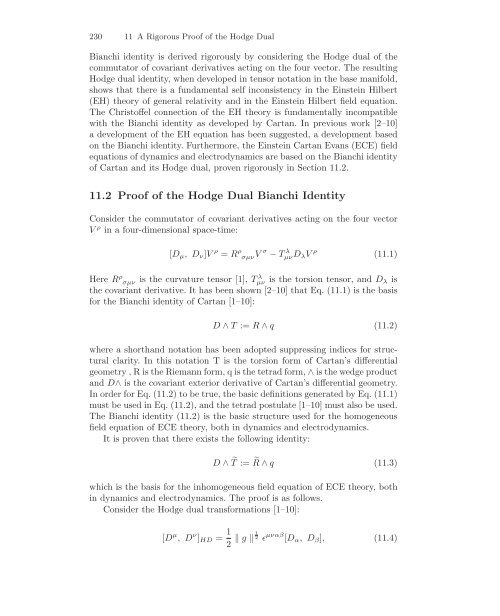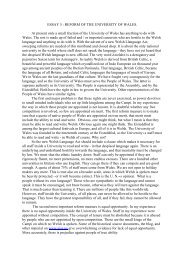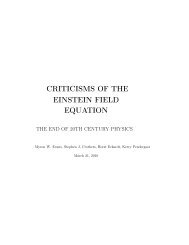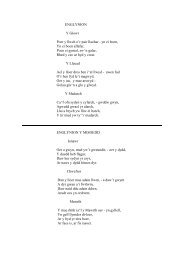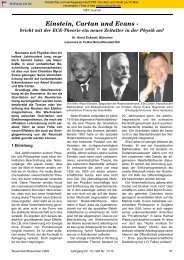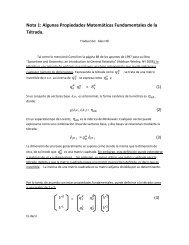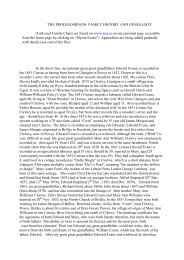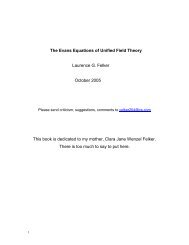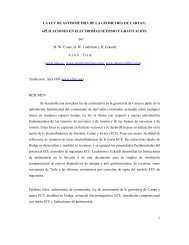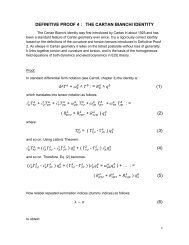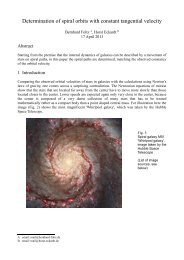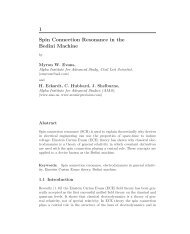11 A Rigorous Proof of the Hodge Dual of the Bianchi Identity of ...
11 A Rigorous Proof of the Hodge Dual of the Bianchi Identity of ...
11 A Rigorous Proof of the Hodge Dual of the Bianchi Identity of ...
You also want an ePaper? Increase the reach of your titles
YUMPU automatically turns print PDFs into web optimized ePapers that Google loves.
230 <strong>11</strong> A <strong>Rigorous</strong> <strong>Pro<strong>of</strong></strong> <strong>of</strong> <strong>the</strong> <strong>Hodge</strong> <strong>Dual</strong><br />
<strong>Bianchi</strong> identity is derived rigorously by considering <strong>the</strong> <strong>Hodge</strong> dual <strong>of</strong> <strong>the</strong><br />
commutator <strong>of</strong> covariant derivatives acting on <strong>the</strong> four vector. The resulting<br />
<strong>Hodge</strong> dual identity, when developed in tensor notation in <strong>the</strong> base manifold,<br />
shows that <strong>the</strong>re is a fundamental self inconsistency in <strong>the</strong> Einstein Hilbert<br />
(EH) <strong>the</strong>ory <strong>of</strong> general relativity and in <strong>the</strong> Einstein Hilbert field equation.<br />
The Christ<strong>of</strong>fel connection <strong>of</strong> <strong>the</strong> EH <strong>the</strong>ory is fundamentally incompatible<br />
with <strong>the</strong> <strong>Bianchi</strong> identity as developed by Cartan. In previous work [2–10]<br />
a development <strong>of</strong> <strong>the</strong> EH equation has been suggested, a development based<br />
on <strong>the</strong> <strong>Bianchi</strong> identity. Fur<strong>the</strong>rmore, <strong>the</strong> Einstein Cartan Evans (ECE) field<br />
equations <strong>of</strong> dynamics and electrodynamics are based on <strong>the</strong> <strong>Bianchi</strong> identity<br />
<strong>of</strong> Cartan and its <strong>Hodge</strong> dual, proven rigorously in Section <strong>11</strong>.2.<br />
<strong>11</strong>.2 <strong>Pro<strong>of</strong></strong> <strong>of</strong> <strong>the</strong> <strong>Hodge</strong> <strong>Dual</strong> <strong>Bianchi</strong> <strong>Identity</strong><br />
Consider <strong>the</strong> commutator <strong>of</strong> covariant derivatives acting on <strong>the</strong> four vector<br />
V ρ in a four-dimensional space-time:<br />
[Dµ, Dν]V ρ = R ρ σµνV σ − T λ µνDλV ρ<br />
(<strong>11</strong>.1)<br />
Here R ρ σµν is <strong>the</strong> curvature tensor [1], T λ µν is <strong>the</strong> torsion tensor, and Dλ is<br />
<strong>the</strong> covariant derivative. It has been shown [2–10] that Eq. (<strong>11</strong>.1) is <strong>the</strong> basis<br />
for <strong>the</strong> <strong>Bianchi</strong> identity <strong>of</strong> Cartan [1–10]:<br />
D ∧ T := R ∧ q (<strong>11</strong>.2)<br />
where a shorthand notation has been adopted suppressing indices for structural<br />
clarity. In this notation T is <strong>the</strong> torsion form <strong>of</strong> Cartan’s differential<br />
geometry , R is <strong>the</strong> Riemann form, q is <strong>the</strong> tetrad form, ∧ is <strong>the</strong> wedge product<br />
and D∧ is <strong>the</strong> covariant exterior derivative <strong>of</strong> Cartan’s differential geometry.<br />
In order for Eq. (<strong>11</strong>.2) to be true, <strong>the</strong> basic definitions generated by Eq. (<strong>11</strong>.1)<br />
must be used in Eq. (<strong>11</strong>.2), and <strong>the</strong> tetrad postulate [1–10] must also be used.<br />
The <strong>Bianchi</strong> identity (<strong>11</strong>.2) is <strong>the</strong> basic structure used for <strong>the</strong> homogeneous<br />
field equation <strong>of</strong> ECE <strong>the</strong>ory, both in dynamics and electrodynamics.<br />
It is proven that <strong>the</strong>re exists <strong>the</strong> following identity:<br />
D ∧ T := R ∧ q (<strong>11</strong>.3)<br />
which is <strong>the</strong> basis for <strong>the</strong> inhomogeneous field equation <strong>of</strong> ECE <strong>the</strong>ory, both<br />
in dynamics and electrodynamics. The pro<strong>of</strong> is as follows.<br />
Consider <strong>the</strong> <strong>Hodge</strong> dual transformations [1–10]:<br />
[D µ , D ν ]HD = 1<br />
1<br />
g 2 ɛ<br />
2 µναβ [Dα, Dβ], (<strong>11</strong>.4)


